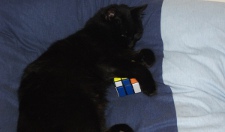Twisting Puzzles
Pocket Cube (2x2x2) - Intermediate Solution
Introduction
This method is based on a well known method called Ortega which would be the first stage of a corners-first approach to solving the 3x3x3 cube. There are 3 steps to the solution.
- Orient the top corners
- Orient the bottom corners
- Permute both layers at the same time
The Ortega method has the advantage of being relatively quick (average approx 20 quarter turns) with a small number of algorithms to learn.
Notation
The notation is as for the simple solution, with the addition of the letters x, y and z. These indicate rotations of the whole cube about that axis. An apostrophe indicates an anti-clockwise rotation. So y' indicates an anti-clockwise rotation of the cube so that the L face becomes the F face.
Step 1- Orient The First Layer
Basically make a white layer without worrying about where the corners are. It doesn't take more than 3 turns to move each corner into place. If you study the cube carefully before starting, you can line up the turns in your head and do this very quickly.
Step 2 - Orient The Second Layer
There are 7 cases not counting fully oriented case. If you are taking the easiest colour to finish when doing the first layer, you can usually spot the orientation case that you are going to get. In the diagrams, the lines outside the puzzle indicate the position of the twisted bottom layer sticker.
| 0 Oriented | 0 Oriented | 1 Oriented | 1 Oriented |
|---|---|---|---|
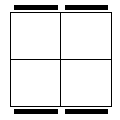 |
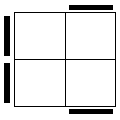 |
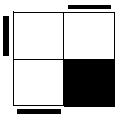 |
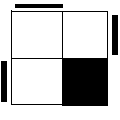 |
| R2 U2 R U2 R2 | R U2 R2 U' R2 U' R2 U2 R |
L' U R U' L U R' | U R U' L' U R' U' L |
| 2 Oriented | 2 Oriented | 2 Oriented |
|---|---|---|
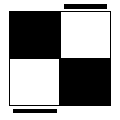 |
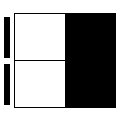 |
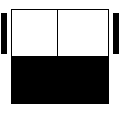 |
| L' U L U F U' F' | F R U R' U' F' | L' U' L U F U F' |
When there is only one oriented cubie, the algorithms are 3-cycles. One is the reverse of the other. The difference between the two cases is easy to spot. With the oriented cubie in the upper front right corner, the top left corner of the front face will either show the same colour or not. If it shows the same colour, do the first algorithm, if not, do the second. Even if you choose the wrong one, doing it again will orient the bottom face.
Similarly, two of the algorithms for 2 oriented pieces are also the reverse of one another. Perform either algorithm on the solved cube and you get the other case.
Step 3 - Permute Both Layers
There are 5 cases not counting the solved case. You can turn the cube over if needed to find the case you are looking for. In the diagrams, the lines indicate correctly placed corners. You are looking for pairs of colours on the sides of the cube.
| Combination Swap | Horizontal Swap - Both Layers |
|---|---|
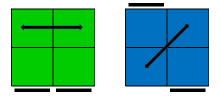 |
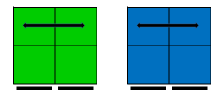 |
| R U' R F2 R' U R' | R2 U R2 y' U2 R2 U R2 |
| Diagonal Swap - Both Layers | Horizontal Swap - Bottom Layer |
|---|---|
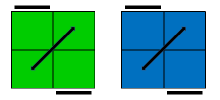 |
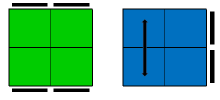 |
| R2 F2 R2 | R' D L D' R D2 L' D L D2 |
| Diagonal Swap - Bottom Layer | |
|---|---|
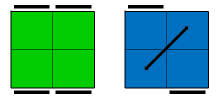 |
|
| F2 D' L D' L' D F2 D L D L' |
About This Method
This is a fairly efficient intermediate method for the pocket cube. After the first layer, you have 2 algorithms to spot and execute to solve the puzzle. Some of the algorithms are slower to execute than others. You can alter them for your own preferences or use Josef Jelinek's ACube program to search for alternatives. Alternatively, you can exercise some control over the permutation case you end up with. The slowest algorithms to execute are those where one layer is solved. If you take care not to position the top layer corners in the first step, you have a greater chance of ending up with one of the other 3 cases. The easiest case occurs about as often as the solved case, so you are left with the double swaps. These are fairly quick algorithms to execute.
An obvious way to speed up this method is to be colour neutral. Many people always begin their solutions with the same colour. On larger puzzles, it helps to spot cases later on. On the pocket cube, as long as you know the opposite colour, it doesn't really matter how you start. If you make the first layer on the bottom, that saves you the time of turning the cube over. The last thing to do is to get used to being able to do the algorithms from any angle (so you don't have to turn the cube around) and being able to do the permutation algorithms with the cube either way up.
With quick fingers and some practice, this method is good for a 5 - 10 second average. You'll find yourself reusing the algorithms on all sorts of other puzzles too - the double horizontal swap is particularly useful on cuboids like the domino or 3x3x4.

